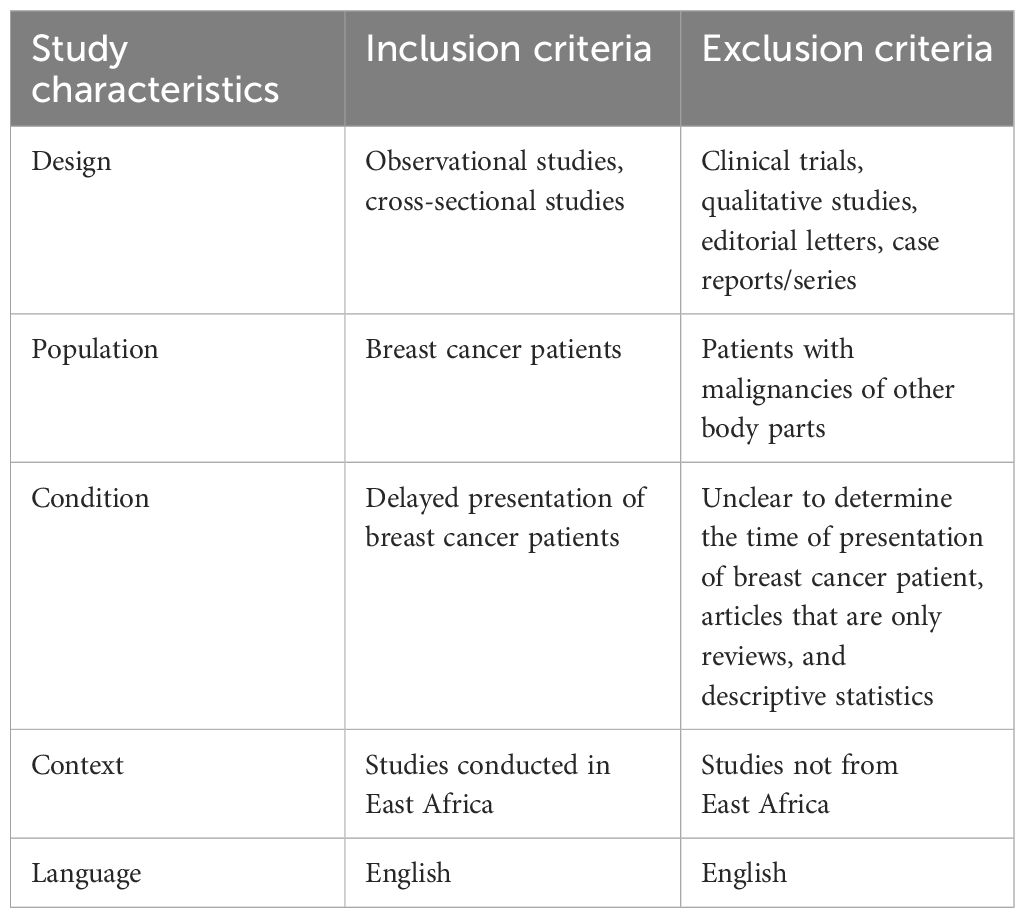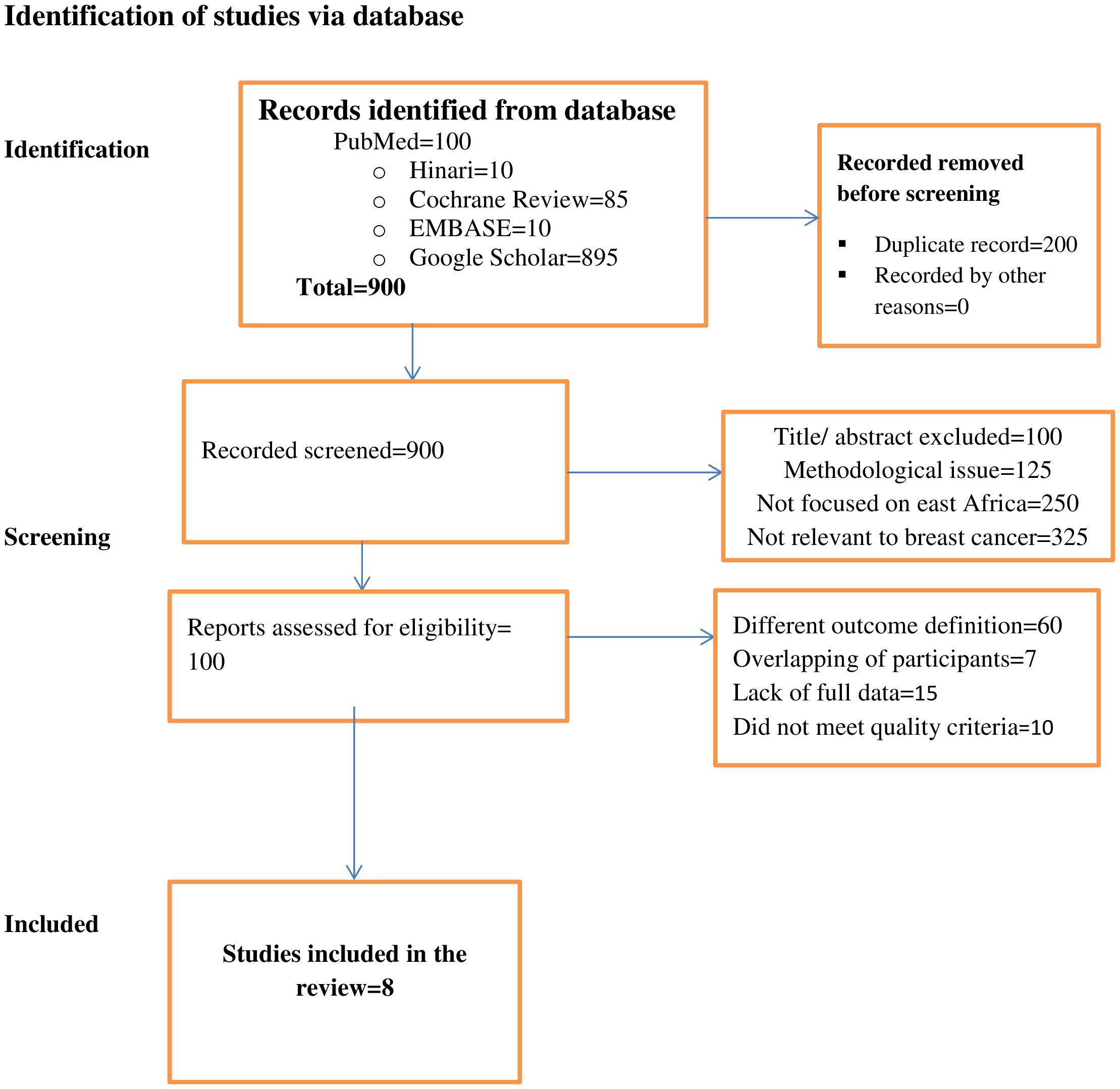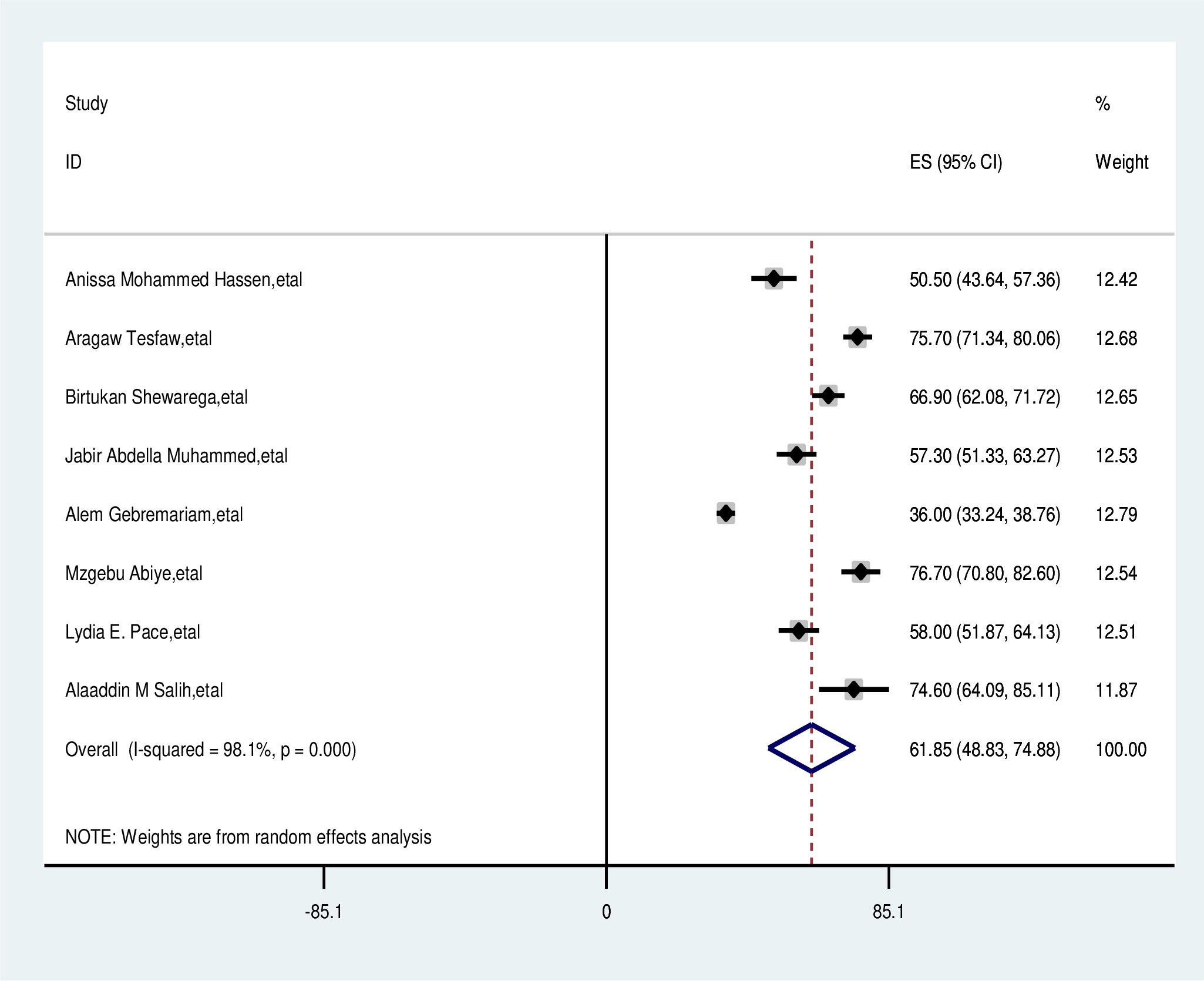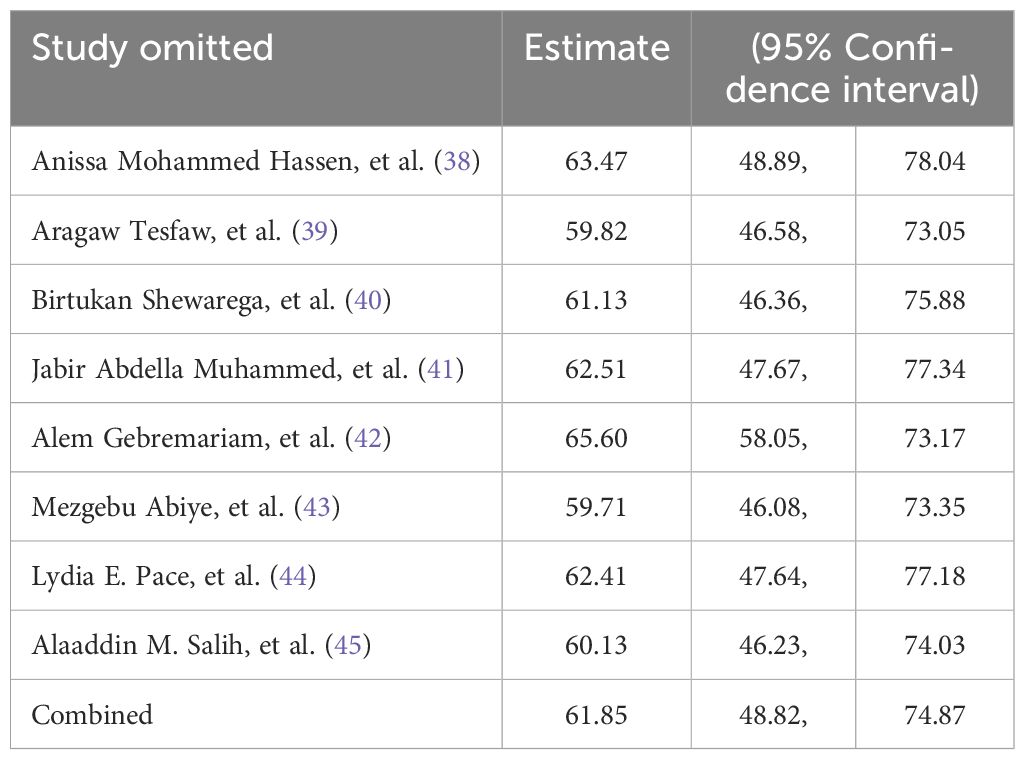- 1Department of Midwifery, College of Health Science, Woldia University, Woldia, Ethiopia
- 2Department Of Medical Laboratory Science, College of Health Science, Woldia University, Woldia, Ethiopia
Introduction: Breast cancer remains a significant public health issue, with delayed medical attention often leading to advanced stages and poorer survival rates. In East Africa, evidence on the prevalence and factors contributing to the delayed presentation of breast cancer is limited. As a result, this study aims to assess the pooled prevalence of delayed breast cancer presentation and identify contributing factors in East Africa.
Methods: We conducted a systematic review of observational studies from East Africa using PubMed, Google Scholar, Embase, Cochrane Library, Hinari, and Mednar databases. The Newcastle Ottawa 2016 Critical Appraisal Checklist assessed methodological quality. Publication bias was evaluated using a funnel plot and Egger’s test, and heterogeneity was examined with the I-squared test. Data were extracted with Microsoft Excel and analyzed using Stata 11.
Results: The pooled prevalence of delayed presentation among breast cancer patients in East Africa was 61.85% (95% confidence interval, 48.83%–74.88%). Significant factors contributing to delayed presentation included visiting traditional healers (adjusted odds ratio, 3.52; 95% CI, 1.43–5.59), low educational levels (adjusted odds ratio, 3.61; 95% CI, 2.39–4.82), age > 40 years (adjusted odds ratio, 1.87; 1.03, 2.71), absence of breast pain (adjusted odds ratio, 2.42; 1.09, 3.74), distance >5 km away from home to health institution (adjusted odds ratio, 2.89; 1.54, 4.24), and rural residence (adjusted odds ratio, 3.33; 95% CI, 2.16–4.49).
Conclusion: This meta-analysis’ findings demonstrated that over half of breast cancer patients in East Africa delayed detection. Significant factors associated with delayed presentation include age over 40 years, illiteracy, rural residence, use of traditional healers, distance >5 km from a health facility, and absence of breast pain. Healthcare stakeholders and policymakers must be focused on raising awareness and educating people to encourage early detection and prompt therapy.
Introduction
Globally, 2.3 million women received a breast cancer diagnosis in 2022, and 670,000 people died from the disease (1). While breast cancer mortality is highest in less developed nations, the disease’s incidence is higher in more developed nations (2). Sub-Saharan Africa as a whole is facing a growing cancer-related public health burden. Currently, 4% of Ethiopian mortalities are related to cancer (3). In Africa, women die from breast cancer at a rate of 20% and account for 28% of all cancer cases. Incidence rates are still generally varied in Africa, estimated below 35 per 100,000 women in most countries (4); in Kenya, 52 (5); in Zimbabwe, 33 (6); and in Uganda, 34 (7) per 100, 000 women were breast cancer incidence.
Today, the World Health Organization announced the Global Breast Cancer Initiative, a significant new cooperative effort aimed at preventing an estimated 2.5 million deaths worldwide from breast cancer by 2.5% year until 2040 (8). To achieve these goals, WHO launched early detection (60% of cases detected in the early stages), prompt diagnosis (60 days), and thorough care (80% of cases completed with treatment) (9). A systematic review and meta-analysis revealed that the average duration between recognizing symptoms and presenting them to a medical professional was <4 months in North Africa and between 3 months and 6 months in Sub-Saharan Africa (10). A similar research conducted in Africa showed that the eastern and central areas had the worst rates of late presentation (>90 days), with an overall estimate of 54% (11). A systematic review and meta-analysis done on breast cancer patients reported that delays of 3 months to 6 months are linked to a decreased chance of survival (12).
Evidence showed that the effects of delay on prognosis have generally demonstrated that longer delays are linked to malignancies that are diagnosed at an advanced stage, which lowers the likelihood of survival (12–14). Longer patient delays were linked to bigger tumor sizes, positive nodes, and a 24% death rate compared to shorter patient delays (15). Longer delays were associated with lower survival rates for women, both from the date of diagnosis and from the beginning of symptoms (16). In a research done on the types and timing of symptoms experienced by breast cancer patients, the disease does not present with a lump at first present with symptoms later and are more likely to have their doctor delayed sending them for a second opinion (17). Previous systematic review and meta-analysis revealed that low education level (10, 18–21), low-income status (10, 18, 21), symptom misinterpretation (11, 22), preference for alternative care (11, 21–23), older age (19, 21), no family history of breast cancer (19), not performing breast self-examination (20, 23), not married (21), poor knowledge about cancer (21, 23), socio-cultural factors such as belief (22, 23), and lack of trust in access healthcare (22) were the contributing factors of late patient presentation of breast cancer.
According to a comprehensive analysis conducted on Asians, breast exams and symptoms have consistently demonstrated a major impact on minimizing the amount of time that a diagnosis is delayed (24). A systematic review done on barriers of late presentation and late-stage diagnosis of breast cancer revealed that poor awareness of symptoms and risk factors, anxiety about finding breast abnormalities, fear of cancer treatments, worry of partner desertion, shame about revealing symptoms to medical experts, taboo, and stigmatism were some of the variables that contributed to patient delays (25). Previous primary studies done worldwide showed that the coverage of late patient presentation of breast cancer ranges from 25% (26) to 89% (27) and positively associated with a range of factors such as individual level [socio-demographic (17, 28, 29), cultural belief (30–32), husband’s attitude and support (27, 32), and family income (33)], health service level (distance, accessibility, and availability) (29, 30, 34), and knowledge level (27, 31, 34) [absence of pain in the breast (35), no family history of breast CA (29), and not practicing self-breast examination (29)].
There was a previous primary research conducted in East Africa to determine the prevalence of delayed presentation of breast cancer patients and associated factors; however, findings from those studies varied across countries. To the best of our knowledge, this topic has not yet been investigated by systematic review and meta-analysis at the regional level. In particular, this study covered a wider geographical area and provided pooled results. This information is necessary for policy planners and program managers to identify gaps in the delayed presentation of breast cancer patients and to plan strategies to reduce the delay of breast cancer patients. The development of successful programs that increase medical-seeking consultation enhances survival rates and decreases mortality and morbidity of breast cancer patients in the East Africa Region, which depends on the identification of a single number of common factors. Early identification and prompt treatment of breast cancer are crucial for improving maternal health Systematic reviews and meta-analyses are necessary to address this issue. Thus, the goal of this study was to assess the pooled prevalence of delayed presentation of breast cancer patients and contributing factors in East Africa.
Methods and materials
Study protocol and reporting
This systematic review and meta-analysis was carried out per the Preferred Reporting Items for Systematic Reviews and Meta-analyses (PRISMA) criteria (36) (Supplementary File S1). The eligibility criteria were adapted from the Newcastle Ottawa 2016 review guidelines (37).We used Endnote (version X7) reference management software to download, organize, and review, and Zotero to cite related articles.
Inclusion criteria
Study area
Only research carried out in East Africa.
Participants in the study
All quantitative studies with indicators or variables indicating late patient presentation of breast cancer.
Study types
Observational cross-sectional studies.
Results of interest
The main investigations revealed the frequency of delayed patient presentation and contributing factors.
Publication condition
We included published articles written in English. There are no restrictions on race and publication date.
Language
Correspondingly, all primary studies published in the English language and reported the prevalence and/or associated factors on delayed presentation of breast cancer patients in East Africa and fulfill the following criteria were included in this review (Table 1).
Exclusion criteria
Excluded from the study were anonymous reports, duplicate research, articles lacking an abstract or full text, and qualitative investigations. We excluded systematic reviews, case reports, and retrospective reviews. We also excluded studies focusing on specific factors and frequency with descriptive studies. Since there was no concrete data to take from this research, they were eliminated. To increase the similarity of the studies included in the meta-analysis with regard to all significant factors, research carried out in particular populations was also eliminated.
Variable measure
Patient delay was defined as time intervals of more than 12 weeks from the first symptom recognition to the first medical consultation (26, 28, 31, 34).
The place of residence was classified as rural or urban, educational status was classified as secondary or above and below secondary, traditional healer was categorized as visit or not visit traditional healer, having no family history of breast cancer was categorized as having a history or not, lump under armpit was grouped into yes or no, and marital status was grouped in to married or not married. Age is grouped into two categories: <40 or ≥40 years. Approximate distance from home to the health facility was grouped into <5 km and >5 km away. Breast pain is grouped as feeling pain or not. Employee was grouped into employee or not employee.
Search strategy
A systematic search of peer-reviewed, published literature in English was conducted to identify the factors contributing to the late presentation of breast cancer in East Africa (Supplementary File S2). We looked through the databases at PubMed, Hinari, EMBASE, Cochrane, CINHAL, Google Scholar, and Mednar to find pertinent research. To find pertinent key phrases, we first searched by article title in PubMed, Google, and Google Scholar. Second, we discovered related ideal keywords. Third, we conducted a second search using these phrases in the databases after looking for more research in the reference lists of all the recognized papers and publications. Terms like “breast cancer,” “associated factors,” “predictors,” “determinants,” “contributing factors,” “prevalence,” “magnitude,” “proportion,” “delayed patient presentation,” “late presentation breast cancer,” “late diagnosis breast cancer,” “late diagnosis of the patient,” “East Africa.” In addition, eastern African countries, namely, Ethiopia, Eritrea, Sudan, South Sudan, Djibouti, Kenya, Rwanda, Zimbabwe, Tanzania, Uganda, Somalia, Burundi, Namibia, Botswana, Reunion, Mayotte, Seychelles, Madagascar, Mauritius, and Democratic Republic of Congo were also included to ensure a comprehensive search. We experimented and improved utilizing several test searches, combining related search phrases with Boolean operators like OR and combining distinct notions using the Boolean operator AND.
Data extraction
The data were extracted using Microsoft Excel. Two distinct data extraction formats were utilized to collect the information needed for analysis. In the extraction form for prevalence, we included the author’s last name, the year the work was published, the study country, the study design, sample size, the frequency of breast cancer, the prevalence and its confidence interval, and the quality score of each study. The author’s last name and the year of publication were also included in the data extraction format for contributing factors. Every necessary piece of information was separately collected by two writers, who then cross-checked their findings and agreed on any discrepancies.
Quality assessment/critical appraisal
The article was manually transferred to EndNote and checked for duplicates. The inclusion and exclusion criteria were applied to review the remaining articles, focusing on patient delayed presentation of breast cancer in East Africa. The Newcastle–Ottawa quality appraisal checklist was used to evaluate the quality of individual studies (37) (Supplementary File S3).
Two reviewers evaluated each primary study individually, and a decision was made to accept or reject based on specific criteria. In case of disagreement, the average score of both reviewers was taken. A study was categorized as good quality if it scored more than 50% on quality assessment indicators. Each cross-sectional study was assessed using eight criteria: inclusion criteria, study subject and setting description, valid measurement of exposure, and identification of confounders using objective criteria, confounder handling strategies, outcome measurement, and statistical analysis. Eight cross-sectional studies met quality criteria and were included in the analysis.
Result
A total of 1,100 published studies (PubMed=100, Hinari=10, Cochrane Review=85, EMBASE=10, and Google Scholar=895) were identified. A total of 200 duplicates were removed, leaving 900 abstracts for evaluation. A total of 800 articles were excluded based on criteria methodological issues, not focused on East Africa, and not relevant for breast cancer. A total of 100 articles were retained for full-text screening, of which 92 articles were further excluded for various reasons, leaving only eight studies for final systematic and meta-analysis. Participant overlap was prevented by using the same data source, and studies were evaluated for quality before inclusion (Figure 1).
Study characteristics
Only eight studies were included in this analysis (38–45). Six articles were included from Ethiopia. Two articles were recruited from Rwanda and Sudan. From the included articles, the study population included 2,842 participants, of whom 1,095 participants delayed patient presentation of breast cancer. The included articles were published. All the included studies were facility-based cross-sectional design and reported delayed presentation of breast cancer patients. The sample sizes across the studies ranged from 63 (45) to 441 (42) (Table 2).

Table 2. Description of included articles delayed presentation of breast cancer and associated factors in East Africa.
Pooled prevalence of delayed patient presentation of breast cancer in East Africa
The overall pooled prevalence of delayed patient presentation of breast cancer was 61.85% (95% CI, 48.83%–74.88%). Using the random effects model, the pooled effect size of delayed patient presentation of breast cancer showed statistically significant heterogeneity among the included studies (I2, 98.1%, p<0001) (Figure 2).
Subgroup analysis
We performed a subgroup analysis by country to address heterogeneity. The subgroup analysis showed that the prevalence of late presentation of breast cancer patients ranged from 50.0% in Rwanda to 74.6% in Sudan. Substantial heterogeneity was estimated, up to 98.6% in Ethiopia (Figure 3).

Figure 3. Subgroup analysis of pooled prevalence delayed presentation of breast cancer patient in East Africa 2024.
Publication bias
Publication bias was viewed graphically by funnel plot asymmetry and tested through Egger’s (46). The p-value was >0.05; there was statistical evidence for the absence of publication bias using the Egger test. Egger’s regression test was not statistically significant, with a p-value of 0.089 (Figure 4).
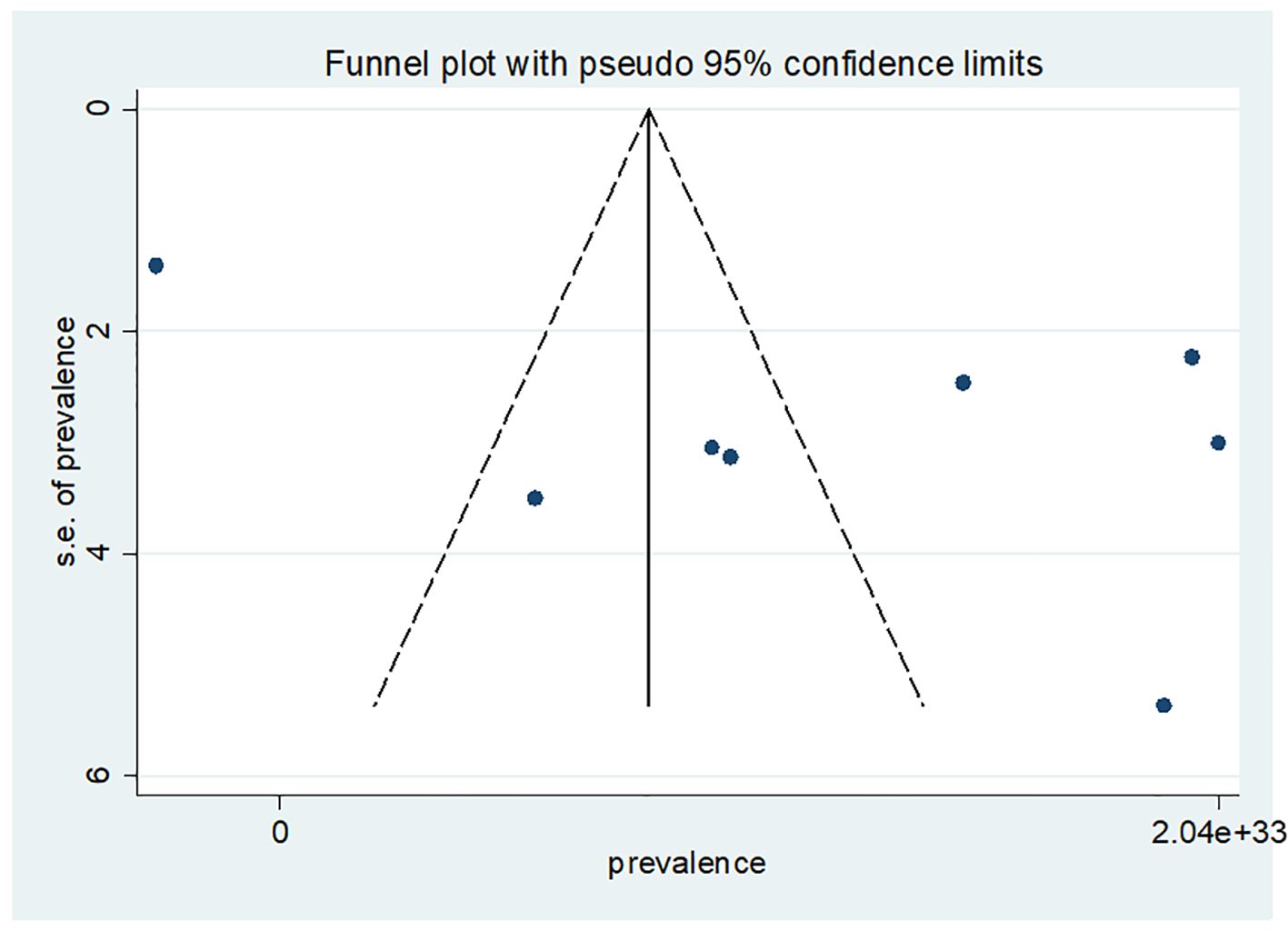
Figure 4. Funnel plot publication bias plot for the prevalence of late presentation of breast cancer patient in East Africa.
Sensitivity analysis
In this meta-analysis, no single study dominated the pooled prevalence of delayed presentation of breast cancer patients in East Africa, according to the results of a random-effects model (Table 3).
Factors associated with delayed presentation of breast cancer patient in East Africa
We included 11 selected variables to identify relationships with the delayed presentation of breast cancer patients in East Africa. Of these, six variables, namely, age ≥ 40 years, low educational level, rural residence, visit traditional healer, distance > 5 km away from the health facility, and not feeling breast pain were significantly associated with delayed presentation of breast cancer patients (Table 4). The review also demonstrated that being an employee, marital status, not having a lump under the armpit, not having awareness of breast cancer, and no family history of breast cancer had no statistically significant association with delayed presentation of breast cancer.
Age of participant
In the overall analysis of this study, age of the participant was significantly associated with delay in presentation of breast cancer patients. Participants with age ≥ 40 years were nearly two times more likely to delayed presentation than those of age <40 years (OR, 1.87; 95% CI, 1.03, 2.71). A random effects model was assumed for the analysis as I2 (99.1%) and Egger test of 0.220 with a p-value of <0.001 showed statistically significant heterogeneity among the included studies for this factor analysis (Figure 5).

Figure 5. Pooled odds ratio for the association between age with delayed presentation of breast cancer patient in East Africa.
Educational status
The overall analysis of studies showed that education had a positive impact on delayed breast cancer patients. Participants with low educational status were 3.6 times more likely delay than their counterparts (OR, 3.61; 95% CI, 2.39, 4.82). A random effects model was assumed for the analysis, as I2 (98.3%) and Egger test 0.118 with a p-value of <0.001 showed statistically significant heterogeneity among the included studies for this factor analysis (Figure 6).
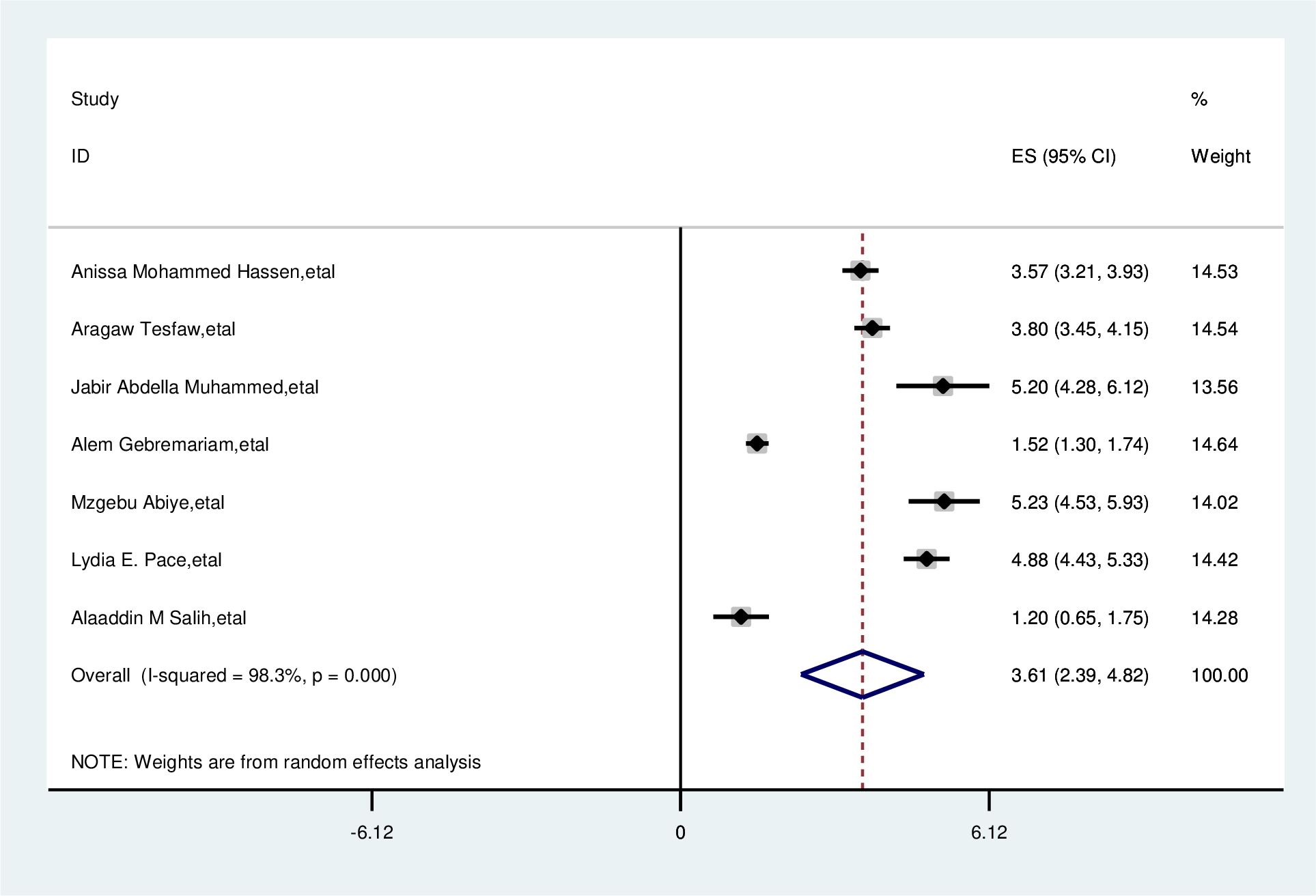
Figure 6. Pooled odds ratio for the association between educational status with delayed presentation of breast cancer patient in East Africa.
Residence
The overall analysis of studies showed that residence had a positive association with delayed presentation of breast cancer patients. Participants with rural residence were 3.3 times more likely to delay than that of their counterparts (OR, 3.33; 95% CI, 2.16, 4.49). A random effects model was assumed for the analysis, as I2 (98.6%) and Egger test of 0.307 with a p-value of (<0.001) showed statistically significant heterogeneity among the included studies for this factor analysis (Figure 7).
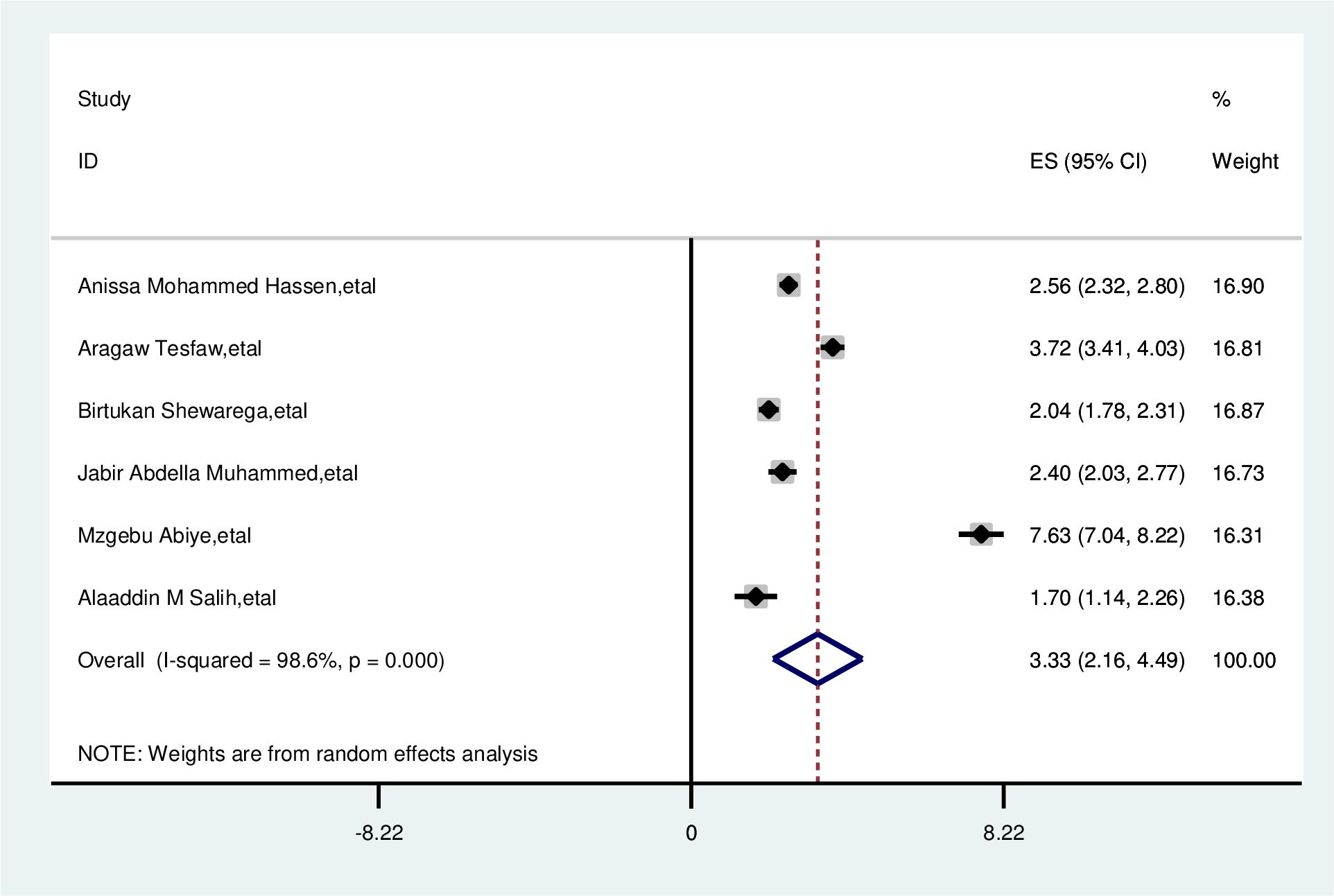
Figure 7. Pooled odds ratio for the association between rural residences with delayed presentation of breast cancer participants in East Africa.
Absence of breast pain
The overall analysis of studies showed that not having breast pain had a positive impact on delayed breast cancer patients. Participants who had no breast pain were 2.4 times more likely to delay than their counterparts (OR, 2.42; 95% CI, 1.09, 3.74). A random effects model was assumed for the analysis, as I2 (99.1%) and Egger test of 0.801 with a p-value of <0.001 showed statistically significant heterogeneity among the included studies for this factor analysis (Figure 8).
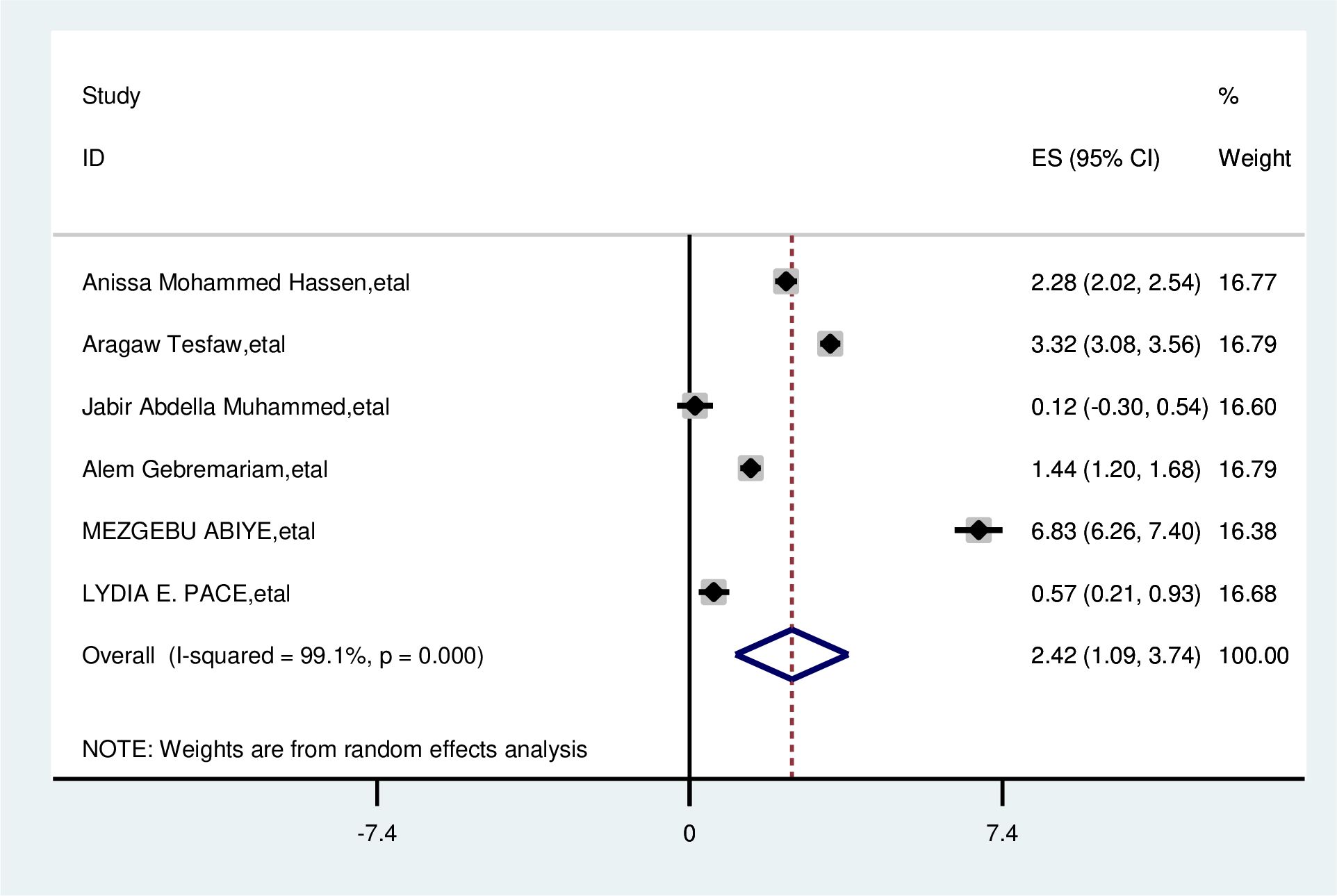
Figure 8. Pooled odds ratio for the association between not having breast pain with delayed presentation of breast cancer participants in East Africa.
Distance from health facility
The overall analysis of studies showed that the distance from the health facility had a positive impact on delayed breast cancer patients. Participants who were >5 km away from the health facility were nearly three times more likely to delay than their counterparts (OR, 2.89; 95% CI, 1.54,4.24). A random effects model was assumed for the analysis as I2 (97.5%) and Egger test of 0.081 with a p-value of <0.001 showed statistically significant heterogeneity among the included studies for this factor analysis (Figure 9).
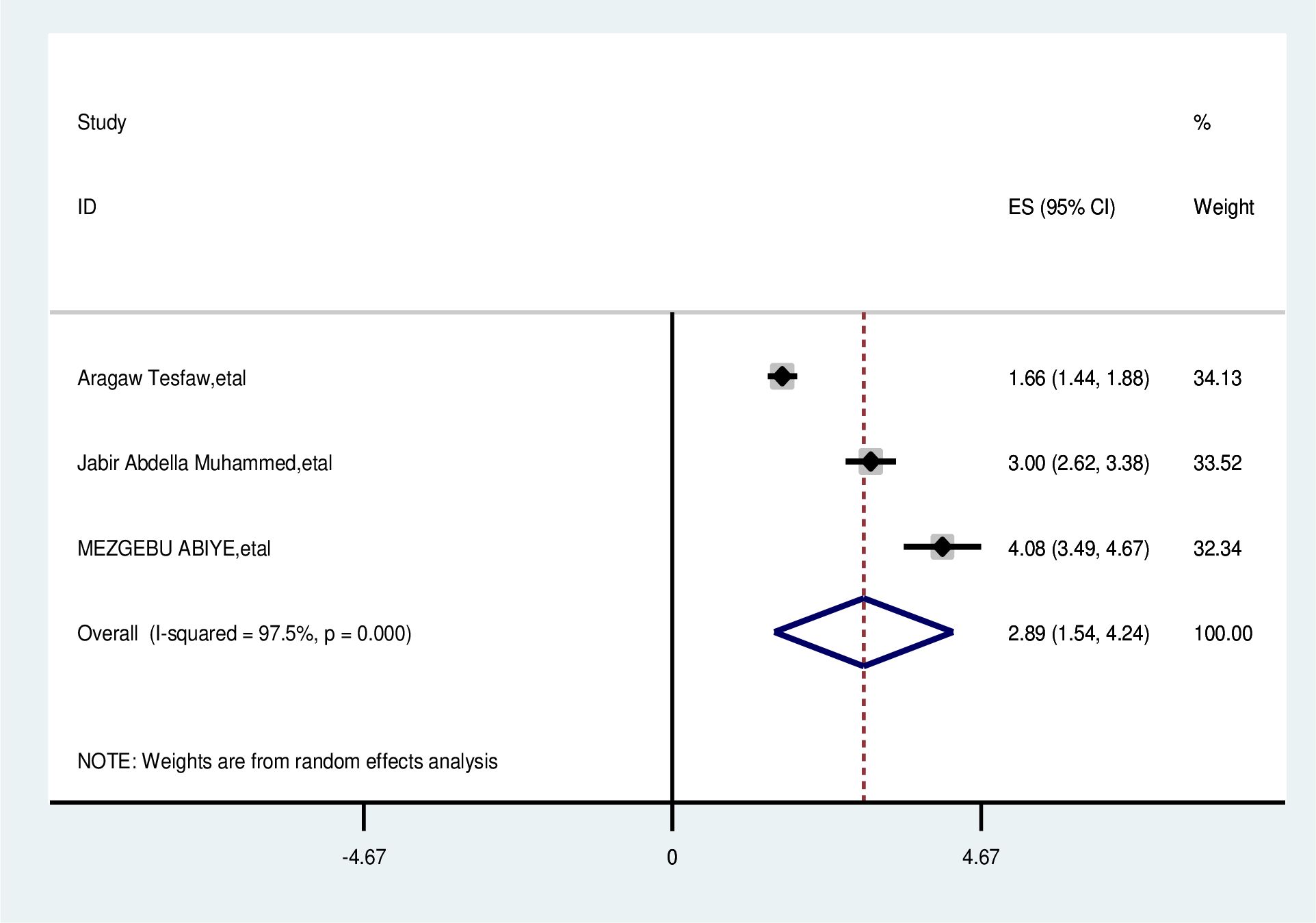
Figure 9. Pooled odds ratio for the association between > 5 km away from health facility with delayed presentation of breast cancer participants in East Africa.
Visit traditional healer
The overall analysis of studies showed that visiting traditional healers had a positive impact on delayed breast cancer patients. Participants who have visited traditional healers were 3.52 times more likely to delay than their counterparts (OR, 3.52; 95% CI, 1.43, 5.59). A random effects model was assumed for the analysis as I2 (99.4%) and Egger test of 0.345 with a p-value of <0.001 showed statistically significant heterogeneity among the included studies for this factor analysis (Figure 10).
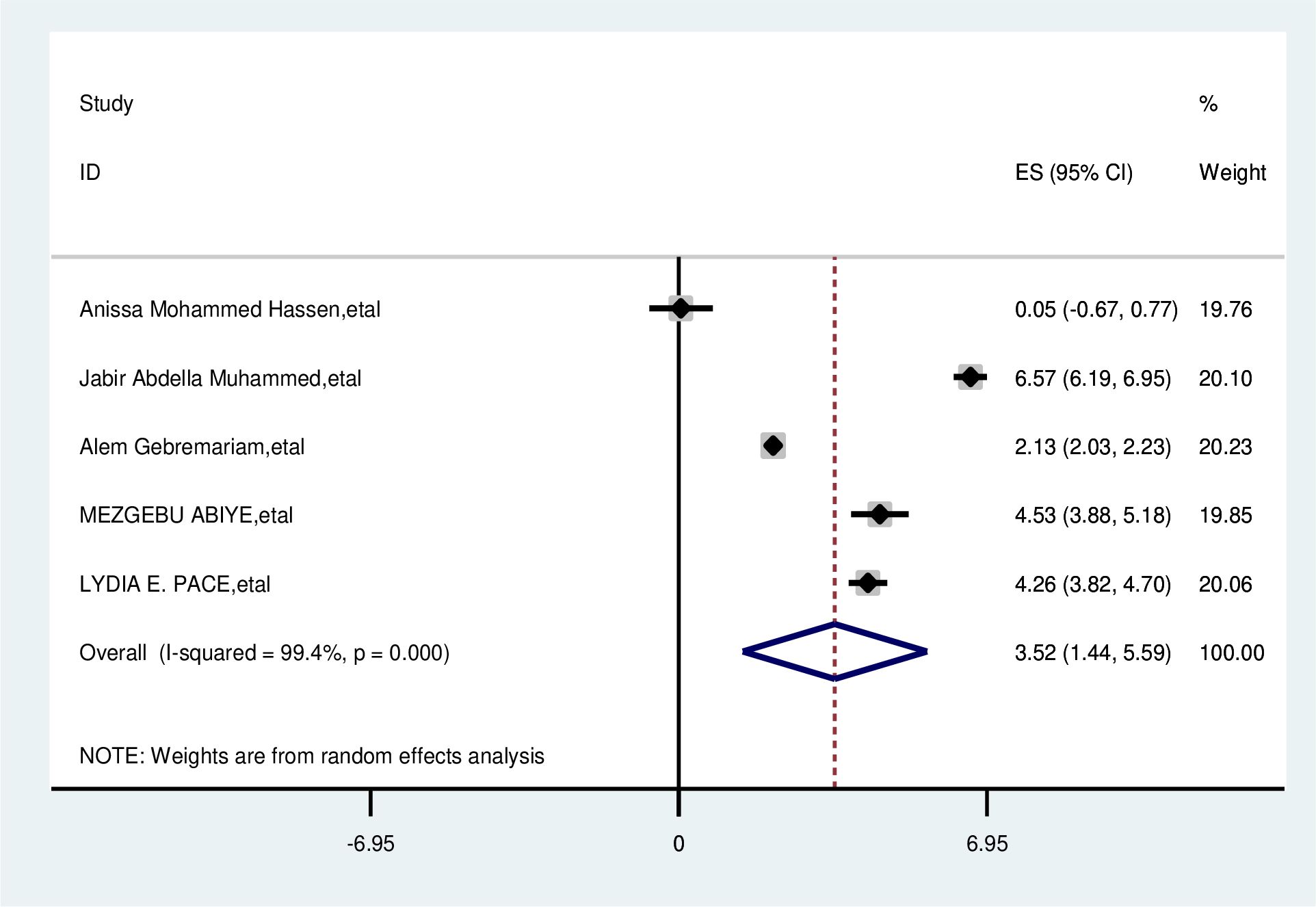
Figure 10. Pooled odds ratio for the association between visit traditional healer with delayed presentation of breast cancer in East Africa.
Factors not associated with delayed presentation of a breast cancer patient in East Africa
Employee
The meta-analysis showed that employed participants were not significantly associated with delayed presentation. The overall odds ratio was 0.63 with a 95% CI of 0.11–1.15 and a p-value of <0.021. A random effects model was used for the analysis, showing statistically significant heterogeneity among the included studies (I2 = 74.4%, p-value <0.021) as depicted in Figure 11.
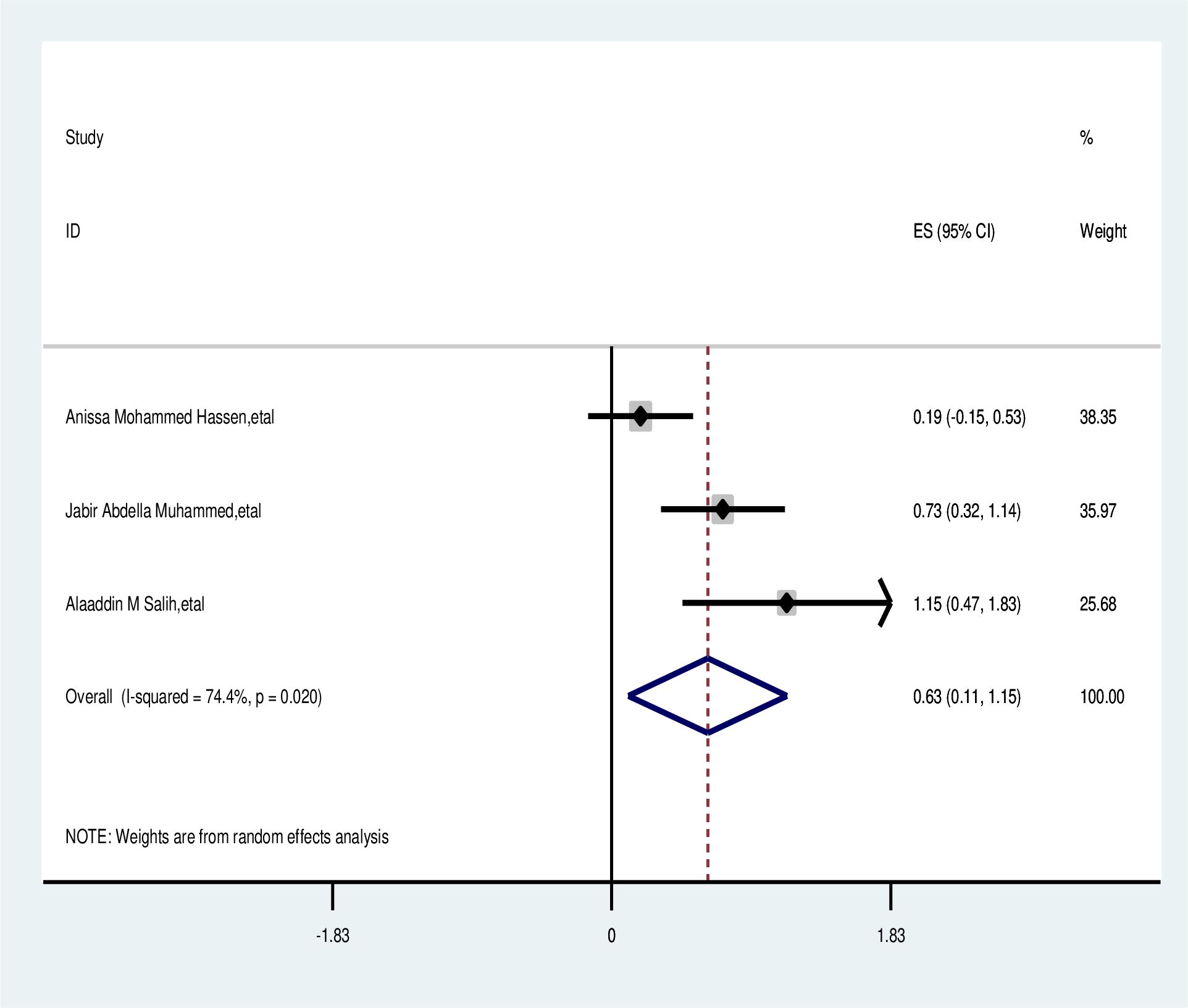
Figure 11. Pooled odds ratio for the association between employed with delayed presentation of breast cancer in Fast Africa.
Marital status
Marital status was not associated with delayed presentation of breast cancer patients. The overall odd ratio of married women is 1.39 (0.90–1.88). Random effect model was used (I2, 93%), and the Egger test was 0.294 with significant heterogeneity for this analysis (Figure 12).

Figure 12. Pooled odds ratio for the association between married with delayed presentation of breast cancer in East Africa.
Not having awareness of breast cancer
The overall analysis of studies showed that not having awareness of breast cancer has no association with delayed presentation of breast cancer patients (OR, 1.58; 95% CI, 0.69, 2.46). A random effects model was assumed for the analysis, as I2 (97.2%) and Egger test of 0.618 with a p-value of (<0.001) showed statistically significant heterogeneity among the included studies for this factor analysis (Figure 13).
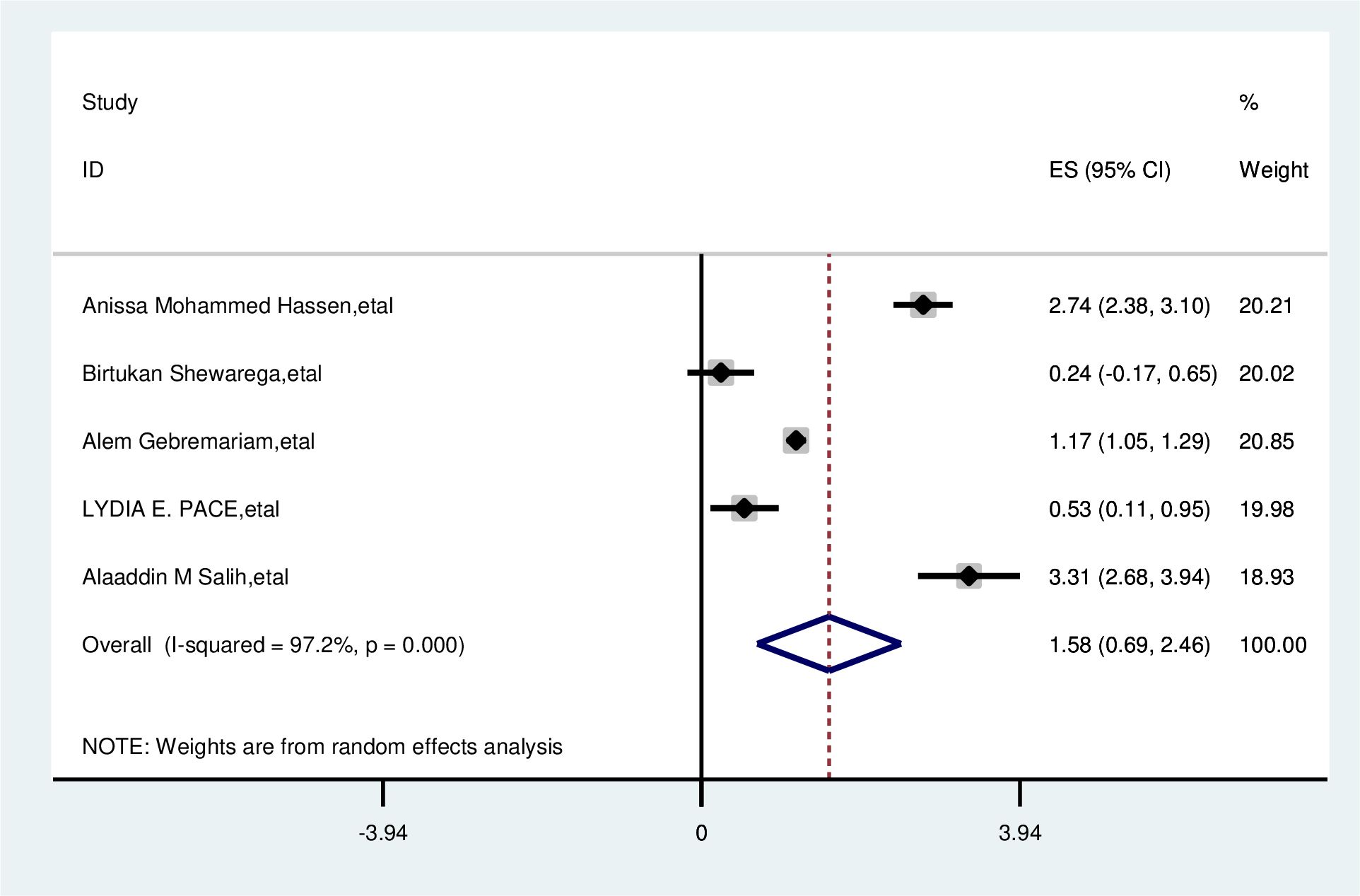
Figure 13. Pooled odds ratio for the association between no awareness of breast cancer with delayed presentation of breast cancer in East Africa.
Not having lump under armpit
The overall analysis of studies showed that no lump under the armpit had no positive impact on delayed breast cancer patients (OR, 3.34; 95% CI, 0.30, 6.38). A random effects model was assumed for the analysis, as I2 (99.7%) and Egger test 0.801 with a p-value of <0.001 showed statistically significant heterogeneity among the included studies for this factor analysis (Figure 14).
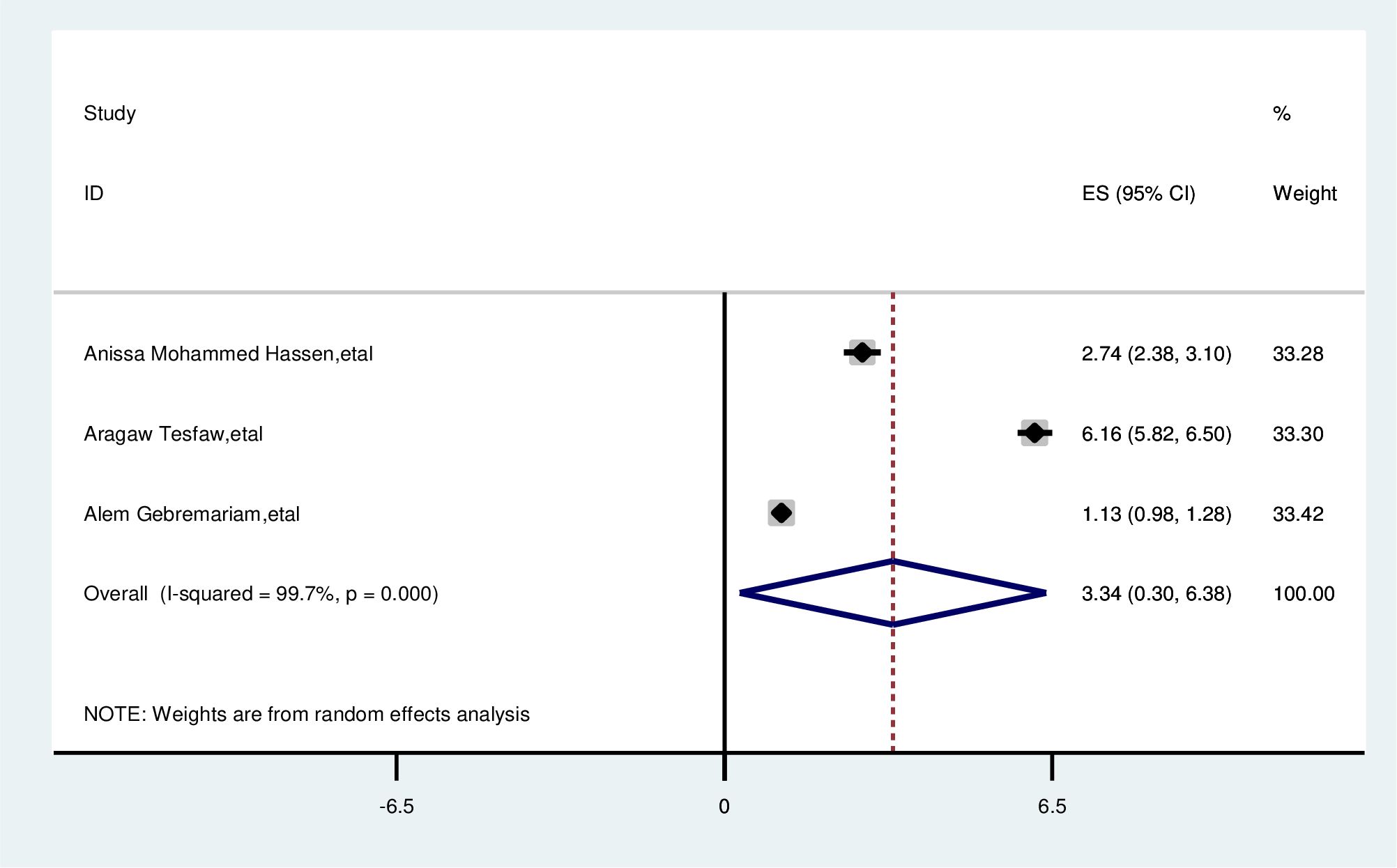
Figure 14. Pooled odds ratio for the association between no lump under armpit with delayed presentation of breast cancer in East Africa.
Have no family history of breast cancer
The overall analysis of studies showed that no family history of breast cancer had no positive effect on delayed breast cancer patients (OR, 2.693; 95% CI, 0.268, 5.118). A random effects model was assumed for the analysis, as I2 (99.7%) and Egger test of 0.611 with a p-value of <0.001 showed statistically significant heterogeneity among analyzed factors (Figure 15).
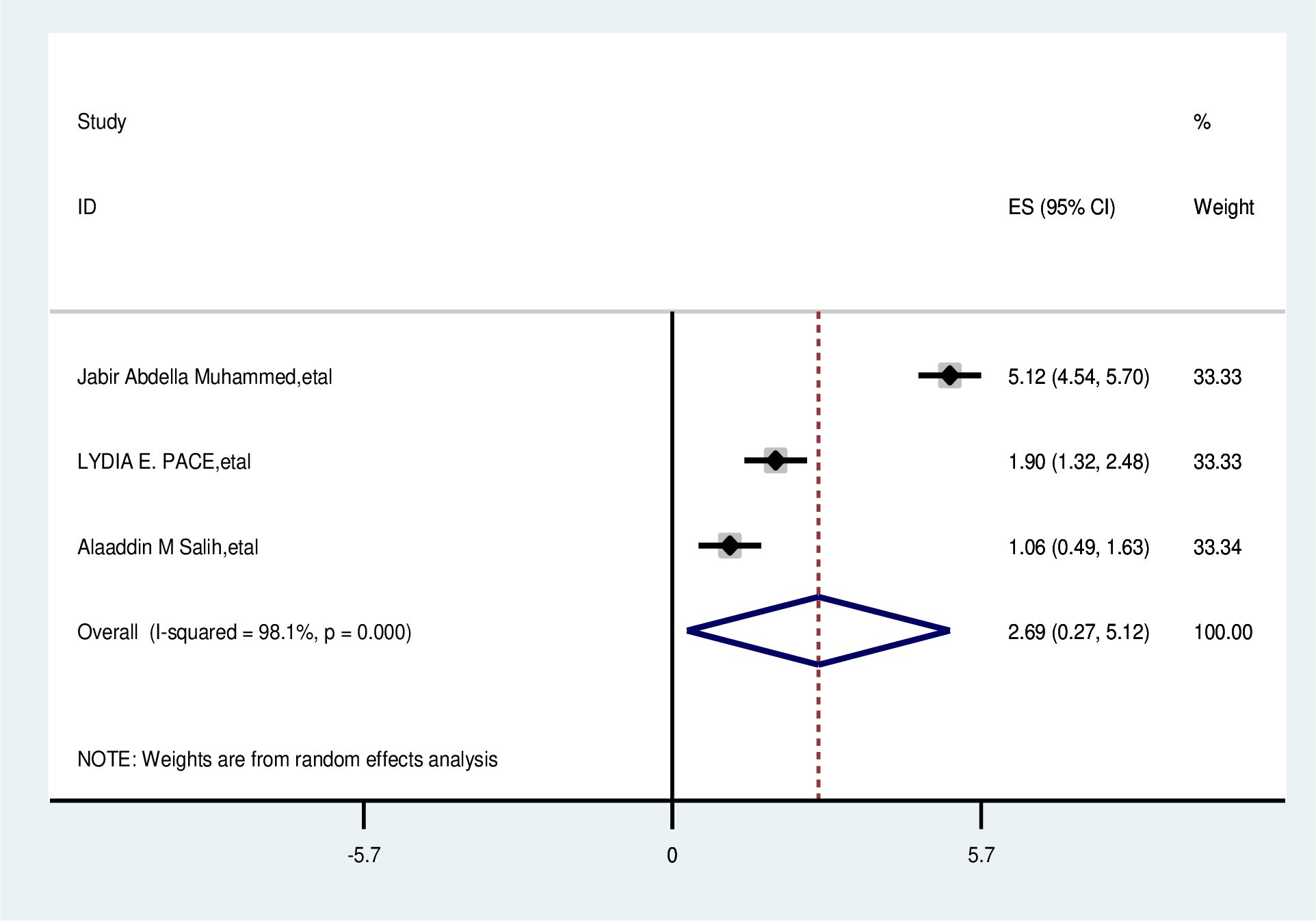
Figure 15. Pooled odds ratio for the association between have no family history of breast cancer with delayed presentation of breast cancer in East Africa.
Discussion
The study conducts a detailed analysis of the coverage of delayed patient presentations for breast cancer in Eastern Africa. Breast cancer patients who delayed presenting were shown to have a pooled overall prevalence of 61.85% (95% CI, 48.83%–74.88%). This high prevalence of delayed presentation of breast cancer has serious implications for public health in East Africa. There might be increased morbidity and mortality, increased economic burden for treatment and exacerbating poverty, and reduced quality of life due to more severe symptoms. Around the world, between 25% and 89% of breast cancer patients present after their disease has progressed. This disparity might be caused by several factors, including access to the healthcare facility, quality of healthcare service, awareness and education level, socioeconomic status, cultural factors, quality of the research, health insurance, financial barriers, the availability of medical supplies, and the article’s publication date.
This study is consistent with previous studies done in different countries in Indonesia, 58% (47); in Nigeria, 72% (48); in Nigeria, 68% (49); a systematic review and meta-analysis done in Africa, 54% (11); in India, 50% (50); and in Saudi Arabia, 60.7% (31). There were a few potential causes, including comparable social levels, cultural beliefs, identical educational backgrounds, and comparable health-seeking habits. However, it was higher than previous research done in Iraq, 44% (51); in Indonesia, 43.4% (47); in Pakistan, 39% (52); in Pakistan, 43.8% (34); and in Iran, 31.7% (33). This high percentage can be explained by socio-demographic factors or by weak or inefficient measures implemented by the competent healthcare authorities in East African regions. Those regions are unstable as a result of natural disasters and conflict, and they also have poor accessibility and availability of health-related services. It might be the poor state of many health systems in East Africa and their declining capacities to lead cancer preventive initiatives and respond to the overall health needs of the population, as compared to developed countries, that are also major concerns (53, 54).
This systematic review and meta-analysis revealed significant heterogeneity among the included studies. The variation is due to data collection methods, measurement of delayed presentation breast cancer, sample size representativeness, regional difference, cultural difference, and quality of the included variables. Addressing these inconsistencies will enhance the comparability of the studies and improve the reliability of the conclusion drawn from this meta-analysis.
The subgroup analysis of the study between countries indicated that the highest level of delayed presentation of breast cancer was in Sudan (74.6%). This is higher than a systematic review and meta-analysis done in Africa (54%) (11). The possible explanation might be a low level of awareness about health-seeking behavior, socio-cultural factors, small sample size, and study design differences.
In this meta-analysis, the contributing factors were the age of more than 40 years, illiterate/low level of education, rural residence, >5 km away from the health facility, visiting traditional healer and not feeling breast pain, which were significantly associated with delayed presentation of a breast cancer patient.
This review found that those aged >40 years were more likely to delay the presentation of breast cancer than their counterparts. This is consistent with a study done in Pakistan (52), in the United Kingdom (55), in Saudi Arabia (31), in Nigeria (49), in the Middle East (19), and in Estonia (56). The possible reason was that age advances decreased health-seeking behavior and prioritized other health issues over breast cancer screening and treatment. There may be a lack of autonomy and fear of sharing the problems with healthcare provider (30–32). However, it contradicts earlier studies (33, 57), because older patients may be anxious about various comorbidities and quickly referred to health institution (58).
These review findings show that illiterate/low level of education breast cancer patients had a stronger association with delayed presentation than educated ones. This is similar to prior studies done in Iraq (51), systematic reviews, and meta-analyses done in different countries (10, 18–21) and in Pakistan (32, 52, 57). The potential explanation of low education is not being aware of the symptoms of breast problems, the belief that symptoms go away by themselves (59), the severity of the disease, and cultural intervention. The more the participant is not educated, the less likely that participant to disclose the symptoms to friends and healthcare providers, as a result of the delay of presentation of breast cancer. Additionally, higher education levels might increase the likelihood of comprehending the health campaign messages with terminology that is not representative of local dialects.
Moreover, this meta-analysis found that rural residence had a strong association with delayed presentation of breast cancer. These figures are similar to a study done in Saudi Arabia (31) and in Pakistan (57). The justification is that the rural part of East Africa region had a low level of awareness about health-seeking consultation and poor healthcare services (accessibility, availability) (29, 30, 34), and they are not near for information. Plus, women who come from rural countries may have difficulty with transportation to a nearby health center and traveling a long distance to get an appropriate diagnosis, which in turn may result in delayed presentation.
This meta-analysis also found that not feeling/absence of breast pain was more likely to delay the presentation of breast cancer than that of counterparts. This is similar to a study done in Iraq (51), in Estonia (56), in Palestinian (60), and in Saudi Arabia (31). The possible reason was that in patients who were asymptomatic, they cannot appreciate the disease, and they believe that mass without pain is normal physiology and resolves spontaneously. This is also correlated with the fact that breast self-examination is important for early detection and decrease in delayed presentation (61).
Furthermore, the review found that participants who visit traditional healers had a strong association with delayed presentation of breast cancer. This is supported by prior studies (11, 21–23). The explanation was that they perceived that traditional healers were more curative than modern medicine, and patients wasted their time with traditional medicine. In addition, because of fear of surgery of the breast and false belief (30–32), they are abstaining from the health institution for healthcare services. Thus, while taking those remedies, most patients delay coming to the health facility leading to worsening of symptoms and advanced stage.
The final significant factor for this research found that distance >5 km from the health facility was a significant factor in the delayed presentation of breast cancer patients. It has been reported that East African women living far from health institutions are particularly vulnerable to late presentation of breast cancer, partially due to the high cost of transportation (30), low socio-economic status (18, 33), transportation problem (30), and wasted time by long journeys to reach healthcare facilities.
Strength of the study
Strengths of this study include our rigorous review of existing published literature, an assessment of study quality and heterogeneity, and providing insight into the reliability of the findings and compressive synthesis of evidence.
Limitations of the study
One of the limitations of the study is the fact that recall bias may not have been eliminated from the study, as almost all studies included in the study were cross-sectional, and it is possible that the outcome variable was under- or overestimated. The findings of this meta-analysis should be done with due consideration of the substantial heterogeneity between included studies. The high heterogeneity indicates that the studies are not sufficiently similar to combine meaningfully, leading to potentially misleading conclusions. Studies that were published only in the English language were taken into account.
We suggest for future researchers the inclusion of diverse study designs, focus on subgroup analysis, and improved statistical techniques for handling heterogeneity and missing data; it is better to take a qualitative approach and also include articles published in different languages.
Conclusion
This meta-analysis found that over half of breast cancer patients in East Africa experience delays in the presentation of breast cancer. Significant factors associated with delayed presentation include age over 40 years, illiteracy, rural residence, use of traditional healers, distance >5 km from a health facility, and absence of breast pain. These results highlight the critical need for targeted public health interventions to address these barriers. Healthcare stakeholders and policymakers focus on enhancing awareness, improving education, and increasing healthcare access, which are essential to reduce delays and improve early detection and treatment of breast cancer in East Africa.
Data availability statement
The original contributions presented in the study are included in the article/Supplementary Material. Further inquiries can be directed to the corresponding author.
Author contributions
CM: Writing – original draft, Writing – review & editing. TE: Writing – review & editing. GK: Methodology, Writing – original draft. BE: Supervision, Writing – review & editing. AA: Supervision, Writing – original draft.
Funding
The author(s) declare that no financial support was received for the research and/or publication of this article.
Acknowledgments
We acknowledge Woldia University for the provision of internet service to conduct this meta-analysis.
Conflict of interest
The authors declare that the research was conducted in the absence of any commercial or financial relationships that could be construed as a potential conflict of interest.
Publisher’s note
All claims expressed in this article are solely those of the authors and do not necessarily represent those of their affiliated organizations, or those of the publisher, the editors and the reviewers. Any product that may be evaluated in this article, or claim that may be made by its manufacturer, is not guaranteed or endorsed by the publisher.
Supplementary material
The Supplementary Material for this article can be found online at: https://www.frontiersin.org/articles/10.3389/fonc.2024.1459613/full#supplementary-material
Supplementary File S1 | The PRISMA checklist dox.
Supplementary File S2 | Newcastle-Ottawa Quality Assessment Scale for cross-sectional studies used in the systematic review and meta-analysis 2024.
Supplementary File S3 | Searching strategy dox.
References
1. Arnold M, Morgan E, Rumgay H, Mafra A, Singh D, Laversanne M, et al. Current and future burden of breast cancer: Global statistics for 2020 and 2040. Breast. (2022) 66:15–23. doi: 10.1016/j.breast.2022.08.010
2. Ghoncheh M, Mohammadian-Hafshejani A, Salehiniya H. Incidence and mortality of breast cancer and their relationship to development in Asia. Asian Pacific J Cancer Prev. (2015) 16:6081–7. doi: 10.7314/APJCP.2015.16.14.6081
3. Ethiopia AA. World Health Organization (2015) Cancer–a growing public health concern for Ethiopia WHO, Africa Region. (2015).
5. Korir A, Okerosi N, Ronoh V, Mutuma G, Parkin M. Incidence of cancer in N airobi, Kenya (2004–2008). Int J cancer. (2015) 137:2053–9. doi: 10.1002/ijc.29674
6. Chokunonga E, Borok M, Chirenje Z, Nyakabau A, Parkin D. Trends in the incidence of cancer in the black population of Harare, Zimbabwe 1991–2010. Int J cancer. (2013) 133:721–9. doi: 10.1002/ijc.28063
7. Wabinga HR, Nambooze S, Amulen PM, Okello C, Mbus L, Parkin DM. Trends in the incidence of cancer in Kampala, Uganda 1991–2010. Int J cancer. (2014) 135:432–9. doi: 10.1002/ijc.v135.2
8. Anderson BO, Ilbawi AM, Fidarova E, Weiderpass E, Stevens L, Abdel-Wahab M, et al. The Global Breast Cancer Initiative: a strategic collaboration to strengthen health care for non-communicable diseases. Lancet Oncol. (2021) 22:578–81. doi: 10.1016/S1470-2045(21)00071-1
10. a CEP. Delayed presentation and diagnosis of breast cancer in Africanwomen: a systematic review. Ann Epidemiol. (2017) 27.
11. S O. Prevalence of themes linked to delayed presentation of breast cancer in africa: AMeta-analysis of patient-reported studies. JCO Global Oncol. (2020) 6.
12. Richards M, Westcombe A, Love S, Littlejohns P, Ramirez A. Influence of delay on survival in patients with breast cancer: a systematic review. Lancet. (1999) 353:1119–26. doi: 10.1016/S0140-6736(99)02143-1
13. Robinson E, Mohilever J, Borovik R. Factors affecting delay in diagnosis of breast cancer: relationship of delay to stage of disease. Israel J Med Sci. (1986) 22:333–8.
14. Burgess C, Ramirez A, Richards M, Love S. Who and what influences delayed presentation in breast cancer? Br J Cancer. (1998) 77:1343–8.
15. Afzelius P, Zedeler K, Sommer H, Mouridsen HT, Blichert-Toft M. Patient’s and doctor’s delay in primary breast cancer: Prognostic implications. Acta Oncol. (1994) 33:345–51.
16. Richards M, Smith P, Ramirez A, Fentiman I, Rubens R. The influence on survival of delay in the presentation and treatment of symptomatic breast cancer. Br J cancer. (1999) 79:858–64. doi: 10.1038/sj.bjc.6690137
17. Macarthur C, Smith A. Delay in breast cancer and the nature of presenting symptoms. Lancet. (1981) 317:601–3. doi: 10.1016/S0140-6736(81)92044-4
18. Sharma K. A systematic review of barriers to breast cancer care in developing countries resulting in delayed patient presentation. J Oncol. (2012). doi: 10.1155/2012/121873
19. Alhurishi S. Factors influencing late presentation for breast cancer in the Middle East: A systematic review. Asian Pacific J Cancer Prev. (2011) 12.
20. Agodirin O. Determinants of delayed presentation and advanced-stage diagnosis of breast cancer in Africa: A systematic review and meta-analysis. Asian Pac J Cancer Prev. (2021) 22. doi: 10.31557/APJCP.2021.22.4.1007
21. Petrova D. Duration of the patient interval in breast cancer and factorsassociated with longer delays in low-and middle-incomecountries: A systematic review with meta-analysis. Psycho-Oncology. (2022) 32:24.
22. Donkor A. Factors contributing to late presentation of breast cancer in Africa: A systematic literature review. Arch OF Med. (2015) 8.
23. Akuoko CP. Barriers to early presentation and diagnosisof breast cancer among African women livingin sub-Saharan Africa. PloS One. (2017) 10.
24. Sobri FB. Factors affecting delayed presentation and diagnosis of breast cancer in asian developing countries women: A systematic review. Asian Pac J Cancer Prev. (2021) 22. doi: 10.31557/APJCP.2021.22.10.3081
25. Jones CEL. A systematic review of barriers to earlypresentation and diagnosis with breastcancer among black women. BMJ Open. (2014) 4. doi: 10.1136/bmjopen-2013-004076
26. Montazeri A, Ebrahimi M, Mehrdad N, Ansari M, Sajadian A. Delayed presentation in breast cancer: a study in Iranian women. BMC women’s Health. (2003) 3:1–6. doi: 10.1186/1472-6874-3-4
27. Odongo J, Makumbi T, Kalungi S, Galukande M. Patient delay factors in women presenting with breast cancer in a low income country. BMC Res notes. (2015) 8:1–6. doi: 10.1186/s13104-015-1438-8
28. Ibrahim N, Oludara M. Socio-demographic factors and reasons associated with delay in breast cancer presentation: a study in Nigerian women. Breast. (2012) 21:416–8. doi: 10.1016/j.breast.2012.02.006
29. Harirchi I, Ghaemmaghami F, Karbakhsh M, Moghimi R, Mazaherie H. Patient delay in women presenting with advanced breast cancer: an Iranian study. Public Health. (2005) 119:885–91. doi: 10.1016/j.puhe.2004.11.005
30. Čačala SR, Gilart J. Factors relating to late presentation of patients with breast cancer in Area 2 KwaZulu-Natal, South Africa. J Global Oncol. (2017) 3:497–501. doi: 10.1200/JGO.2016.008060
31. Altwalbeh D, El Dahshan M, Yassin R. Factors influencing delayed presentation of breast cancer among Saudi women. Int J Sci Res. (2015) 1:967–74.
32. Shamsi U, Khan S, Azam I, Usman S, Maqbool A, Gill T, et al. Patient delay in breast cancer diagnosis in two hospitals in Karachi, Pakistan: preventive and life-saving measures needed. JCO Global Oncol. (2020) 6:873–83. doi: 10.1200/GO.20.00034
33. Harirchi I, Karbakhsh M, Hadi F, Madani SS, Sirati F, Kolahdoozan S. Patient delay, diagnosis delay and treatment delay for breast cancer: comparison of the pattern between patients in public and private health sectors. Arch Breast Cancer. (2015) 52-7.
34. Baig M, Sohail I, Altaf HN, Altaf OS. Factors influencing delayed presentation of breast cancer at a tertiary care hospital in Pakistan. Cancer Rep. (2019) 2:e1141. doi: 10.1002/cnr2.1141
35. Stapleton JM, Mullan PB, Dey S, Hablas A, Gaafar R, Seifeldin IA, et al. Patient-mediated factors predicting early-and late-stage presentation of breast cancer in Egypt. Psycho-Oncology. (2011) 20:532–7. doi: 10.1002/pon.1767
36. Page MJ, McKenzie JE, Bossuyt PM, Boutron I, Hoffmann TC, Mulrow CD, et al. The PRISMA 2020 statement: an updated guideline for reporting systematic reviews. Int J surge. (2021) 88:105906. doi: 10.1016/j.ijsu.2021.105906
37. Downes MJ. Development of a critical appraisal toolto assess the quality of cross-sectionalstudies (AXIS). BMJ Open. (2016) 6. doi: 10.1136/bmjopen-2016-011458
38. Hassen AM, Hussien FM, Asfaw ZA, Assen HE. Factors associated with delay in breast cancerpresentation at the only oncology center in North East Ethiopia: a cross-sectional study. J of multidisciplinary healthc. (2021), 681–94. doi: 10.2147/JMDH.S301337
39. Tesfaw A, Demis S, Munye T, Ashuro Z. Patient delay and contributing factors among breast cancer patients at two cancer referral centres in Ethiopia: a cross-sectional study. J Multidiscip Healthc. (2020), 1391–401. doi: 10.2147/JMDH.S275157
40. Shewarega B, Getachew S, Assefa N, Yesufe A, Trabizsch J, Dandena Y, et al. Predictors of advanced-stage presentation among breast and cervical cancer patients in Ethiopia. medRxiv. (2023). doi: 10.1101/2023.12.16.23300078
41. Muhammed JA, Kroeber ES, Deribe B, Unverzagt S, Taylor L, Aynalem A, et al. Prevalence and factors associated with delay in presentation of breast cancer patients in Ethiopia: A cross-sectional institution-based study. medRxiv. (2022). doi: 10.1101/2022.11.01.22281792
42. Gebremariam A, Addissie A, Worku A, Assefa M, Pace LE, Kantelhardt EJ, et al. Time intervals experienced between first symptom recognition and pathologic diagnosis of breast cancer in Addis Ababa, Ethiopia: a cross-sectional study. BMJ Open. (2019) 9:e032228. doi: 10.1136/bmjopen-2019-032228
43. Abiye M, Assefa A, Mohammedsani B. Delay And Contributing Factors In Patients With Breast Cancer At Hiwot Fana Comprehensive Specialized Hospital, Harar. Eastern Ethiopia: Haramaya University Harar (2023).
44. Pace LE, Mpunga T, Hategekimana V, Dusengimana J-MV, Habineza H, Bigirimana JB, et al. Delays in breast cancer presentation and diagnosis at two rural cancer referral centers in Rwanda. The oncol. (2015) 20:780–8. doi: 10.1634/theoncologist.2014-0493
45. Salih AM, Alfaki MM, Alam-Elhuda DM, Nouradyem MM. Factors delaying presentation of Sudanese breast cancer patients: an analysis using Andersen’s model. Asian Pacific J Cancer Prev. (2016) 17:2105–10. doi: 10.7314/APJCP.2016.17.4.2105
46. Egger M, Davey Smith G, Schneider M, Minder C. Bias in meta-analysis detected by a simple, graphical test. BMJ (Clinical Res ed). (1997) 315:629–34. doi: 10.1136/bmj.315.7109.629
47. Hutajulu SH, Prabandari YS, Bintoro BS, Wiranata JA, Widiastuti M, Suryani ND, et al. Delays in the presentation and diagnosis of women with breast cancer in Yogyakarta, Indonesia: a retrospective observational study. PloS One. (2022) 17:e0262468. doi: 10.1371/journal.pone.0262468
48. Awofeso O, Roberts AA, Salako O, Balogun L, Okediji P. Prevalence and pattern of late-stage presentation in women with breast and cervical cancers in Lagos University Teaching Hospital, Nigeria. Nigerian Med J. (2018) 59:74–9. doi: 10.4103/nmj.NMJ_112_17
49. Elenwo SN, Ijah RFOA, Dimoko AA. Factors associated with late presentation of breast cancer in a Teaching Hospital in Port Harcourt, Nigeria. Nigerian Health J. (2022) 22:140–52.
50. Thakur N, Humne A, Godale L. Delay in presentation to the hospital and factors affecting it in breast cancer patients attending tertiary care center in Central India. Indian J cancer. (2015) 52:102–5. doi: 10.4103/0019-509X.175602
51. Abdulkareem AA, Ghalib HA, Rashaan MI. Factors Causing Delayed Presentations of Breast Cancer among Female patients in Sulaimaniyah Governorate, Iraq. Research Square. (2023). doi: 10.21203/rs.3.rs-2667009/v1
52. Khan MA, Hanif S, Iqbal S, Shahzad MF, Shafique S, Khan MT. Presentation delay in breast cancer patients and its association with sociodemographic factors in North Pakistan. Chin J Cancer Res. (2015) 27:288.
53. Gbenonsi G, Boucham M, Belrhiti Z, Nejjari C, Huybrechts I, Khalis M. Health system factors that influence treatment delay in women with breast cancer in sub-Saharan Africa: A systematic review. Cancer Epidemology, Biomarker and Prevention. (2021). doi: 10.21203/rs.3.rs-234691/v1
54. Gbenonsi G, Boucham M, Belrhiti Z, Nejjari C, Huybrechts I, Khalis M. Health system factors that influence diagnostic and treatment intervals in women with breast cancer in sub-Saharan Africa: a systematic review. BMC Public Health. (2021) 21:1–20. doi: 10.1186/s12889-021-11296-5
55. Simon AE, Waller J, Robb K, Wardle J. Patient delay in presentation of possible cancer symptoms: the contribution of knowledge and attitudes in a population sample from the United Kingdom. Cancer Epidemiol Biomarkers Prev. (2010) 19:2272–7. doi: 10.1158/1055-9965.EPI-10-0219
56. Innos K, Padrik P, Valvere V, Eelma E, Kütner R, Lehtsaar J, et al. Identifying women at risk for delayed presentation of breast cancer: a cross-sectional study in Estonia. BMC Public Health. (2013) 13:1–7. doi: 10.1186/1471-2458-13-947
57. Gulzar F, Akhtar MS, Sadiq R, Bashir S, Jamil S, Baig SM. Identifying the reasons for delayed presentation of Pakistani breast cancer patients at a tertiary care hospital. Cancer Manage Res. (2019), 1087–96. doi: 10.2147/CMAR
58. Macleod U. Risk factors for delayed presentation and referral of symptomatic cancer: evidence for common cancers. Br J Cancer. (2019) 19.
59. Nosarti C. Delay in presentation symptomatic referals to breast clinic:patient and system factors. Br J Cancer. (2015) 82.
60. Al-Shiekh SSA. Factors affecting delay in the presentation of breast cancer symptoms among women in Gaza, occupied Palestinian territory: a cross-sectional survey. BMJopen. (2022) 12. doi: 10.1136/bmjopen-2022-061847
Keywords: delay breast cancer, delay presentation, breast cancer, associated factors, East Africa
Citation: Mulugeta C, Emagneneh T, Kumie G, Ejigu B and Alamrew A (2025) Predictors of survival among breast cancer patients in Ethiopia: a systematic review and meta-analysis. Front. Oncol. 14:1459613. doi: 10.3389/fonc.2024.1459613
Received: 04 July 2024; Accepted: 25 September 2024;
Published: 03 April 2025.
Edited by:
Fabio Puglisi, University of Udine, ItalyReviewed by:
Dario Trapani, European Institute of Oncology (IEO), ItalyCamilla Lisanti, Aviano Oncology Reference Center (IRCCS), Italy
Copyright © 2025 Mulugeta, Emagneneh, Kumie, Ejigu and Alamrew. This is an open-access article distributed under the terms of the Creative Commons Attribution License (CC BY). The use, distribution or reproduction in other forums is permitted, provided the original author(s) and the copyright owner(s) are credited and that the original publication in this journal is cited, in accordance with accepted academic practice. No use, distribution or reproduction is permitted which does not comply with these terms.
*Correspondence: Chalie Mulugeta, Y2hhbGllbXVsdTE5QGdtYWlsLmNvbQ==
†ORCID: Chalie Mulugeta, orcid.org/0009-0008-9038-7996
 Chalie Mulugeta
Chalie Mulugeta Tadele Emagneneh
Tadele Emagneneh Getinet Kumie2
Getinet Kumie2